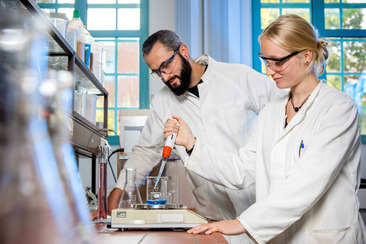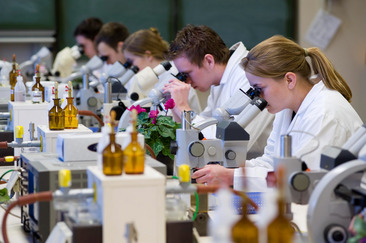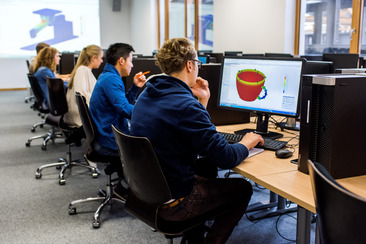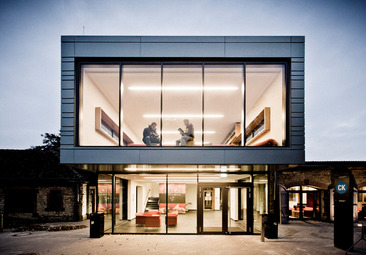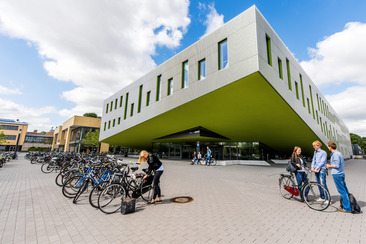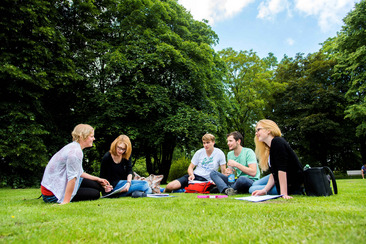WIR portrait
This is what the Osnabrück University of Applied Sciences stands for
The Osnabrück University of Applied Sciences has a high reputation in the region and far beyond. It is the largest and highest performance university of applied sciences in Lower Saxony. Four faculties (Agricultural Sciences and Landscape Architecture, Engineering and Computer Science, Management, Culture and Technology in Lingen, as well as Business Management and Social Sciences) and the Institute of Music form the backbone of the university at the two locations in Osnabrück and Lingen.
With around 110 degree programs, the Bachelor's, Master's and advanced training levels is truly comprehensive. Our university has been a pioneer in many areas of academic training – in the establishment of new degree programs, for example – and has thus earned the reputation of being an innovative and progressive institution of higher education. Now with 13,700 students (as of dec. 2016), our ever-growing university has reached an impressive size. Nonetheless, it has cultivated and maintained the character of a familiar and personal place of teaching and learning.
Lower Saxony's leader in research among universities of applied sciences
The university has a noteworthy research orientation. It is committed to the approach of a "University of Applied Sciences". That is, the university is actively involved in society and sees research as an essential contribution to practically assist in solving socially relevant issues. It places great emphasis on a close dialog with its economic, social and political environment. "Healthcare services research, care management and informatics in healthcare", "Pioneering agricultural system technologies", "Innovative materials and material technologies" as well as "Energy systems, management and law" are four of the profile-defining research concentrations.
With the establishment now of five domestic research priorities on the issues of inclusion, the energy supply of the future, urban agriculture, musician's health and organizational communication, the university provides considerable impetus for cross-disciplinary research. The domestic research is funded through internal funds alone.
Modern infrastructure
The university is a member of the University Alliance UAS7. In this consortium, seven universities of applied sciences from all over Germany cooperate to advance their international orientation. There are UAS7 offices in New York and S?o Paulo. Due to the strength of its research, the university is also a member of the European University Association (EUA). The network of international relations is large and includes more than 200 partner universities all over the world. In 2013, the Hochschulzentrum China (HZC) was founded at the the university.
The new, modern campus in the Lingen locomotive sheds, a new laboratory in the field of food science, new canteens at the Westerberg and Lingen locations, a new lecture hall and the new library at the campus of Westerberg: These are only a few examples of how a modern infrastructure has been created in recent years. The university is continuously active in this field.
Grown in and with the region
The Lingen Campus has been integrated in the former railway repair plant; the new cafeteria at Westerberg blends in to the overall architectural picture of the former Von Stein Barracks with its bright facing bricks. And the Teaching and Research Center Food Science has found a stylish home in the heritage-listed Osnabrück countryside restaurant "Schmied im Hone". These buildings contain an inherent message: The university has grown in and with the region.
An employer for more than 1,200 people
The Osnabrück University of Applied Sciences was founded in 1971. With effect from 1 January 2003, it passed into the sponsorship of the Stiftung 'Fachhochschule Osnabrück’ as an incorporated foundation under public law. This provides us with important design leeway while demonstrating a significant sign of trust from the country with regard to the university's performance. For the university, it was of particular value in the recent years to be able to quickly respond to the growing needs in the personnel area. Also as a building owner, we can specifically meet the needs of the faculty, researchers and students. In the amendment to the NHGs from June 2010, the Fachhochschule Osnabrück was renamed 188篮球比分_188比分直播—激情赢盈中√ Osnabrück.
The university provides jobs for more than 300 professors and approximately 900 employees. The aim is to give maximum possible development opportunities to all university staff and to create framework conditions that support the balance of family and career.
Socially committed
The Osnabrück University of Applied Sciences sees its responsibility as not only providing technical and transferable skills, but shaping attitudes and promoting open-minded personalities with their offers within the framework of a course of studies. Also in the approach of social commitment lies the opportunity for a transregional profiling of the university
We hope that our students stay curious and test themselves at this particular stage of life. They should take time - in any form whatsoever - to commit themselves to the common good or to gain experience abroad. It is important for personal development to study conscientiously and it is also important to use the existing scope of development outside of studies.
In short: The spaces and scopes of development for successful studies and successful research are available at the Osnabrück University of Applied Sciences. For these guiding principles, refer to the position paper "Project 2023 (in German)" of the Osnabrück University of Applied Sciences.
